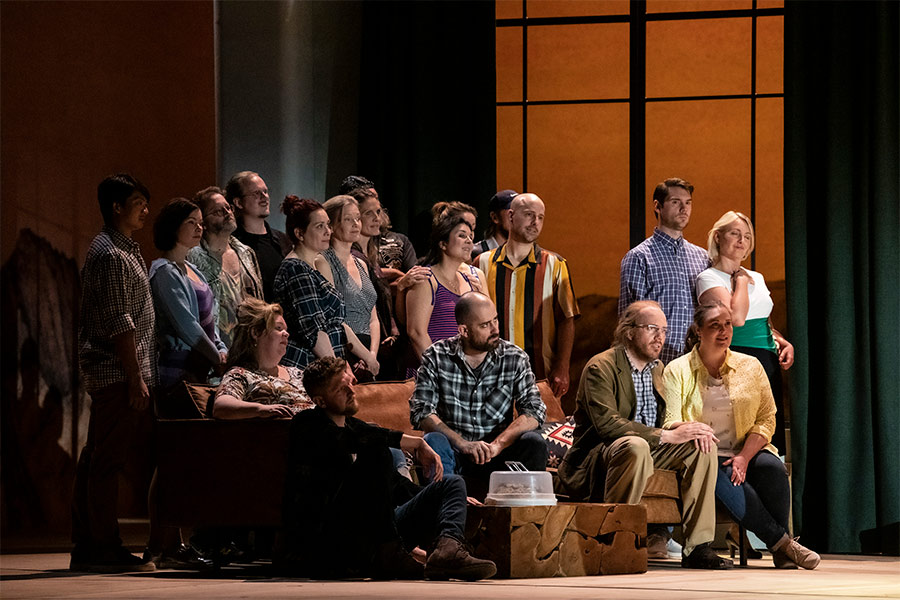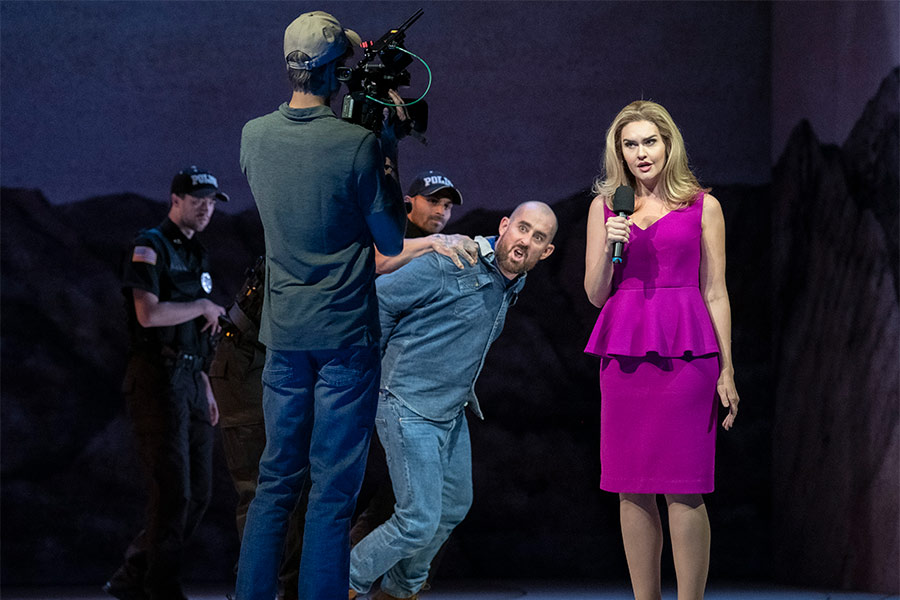March 11, 2025
Longing to Belong
In its reckoning with an invisible sound, Missy Mazzoli and Royce Vavrek's opera The Listeners delivers a haunting meditation on perception, power, and collective delusion. Through an intricate sonic landscape that blurs the line between external reality and crippling inner obsession, the opera explores how disorientation can foster belief, how sound may become a tool of both revelation and control, and how the search for meaning can spiral into hysteria. In the opera, a cult-like leader has emerged, intent on deceiving a group of suffering yet acquiescent followers. The Listeners is as much an auditory labyrinth as it is a psychological one, amplifying modern anxieties over technology, while immersing its audience in the unsettling politics of listening.
The opera critiques sociopolitical structures that take advantage of the defenseless, illustrating how sound — both real and imagined — can become a catalyst for manipulation, coercion, and the construction of alternative realities. Sometimes we may hear a noise that we can't quite put our finger on. A nondescript din. We may simply put music on in the background to mask the sound of a hum. Maybe that hum is a clinical side-effect, a ringing in the inner ear. But when is it something more?
Vavrek crafted his libretto for The Listeners based on an original story by fellow-Canadian author and playwright Jordan Tannahill. A three-company commission from the Norwegian National Opera (where the opera was premiered in September 2022), Opera Philadelphia (which staged the U.S. premiere in September 2024), and Lyric Opera of Chicago, the work is Mazzoli and Vavrek's fourth collaboration of six total. Songs from the Uproar: The Lives and Deaths of Isabelle Eberhardt (2012) began their critically acclaimed run, followed by Breaking the Waves (2016) and Proving Up (2018). Both the Metropolitan Opera commission for an operatic adaptation of George Saunders's novel Lincoln in the Bardo, and The Galloping Cure, a co-commission with San Francisco Opera and the Edinburgh International Festival, among others, will premiere in 2026.
The Listeners was in part born out of the political aftermath of the 2016 election in the United States. Mazzoli recognized that Americans were "divided as a society, increasingly drawn towards our own echo chambers." An awareness of that silo effect served as an inspiration for The Listeners. Mazzoli recalls: "I wanted to create an opera about power imbalances and a middle-aged woman who finds herself in an extreme situation. When this is transformed into a dramatic distillate, the result can be summed up as a cult."
Increasingly desperate people embody the dramatic essence Mazzoli describes. They seek comfort and relief. The confluence of fear, anxiety, hopelessness, and the unknown create a nexus of incredible vulnerability. The relentless hum in the opera — heard only by some — serves as a metaphor for the way isolation and uncertainty drive individuals toward collective belief systems, conspiracy theories, and cult-like devotion.

The group of Listeners initially gathers and finds solace.
The results, in The Listeners, are chilling and extreme. The work occupies a liminal space in American society in the twenty-first century — residing between the nodes of fact-based reality and those of a small group who hear something most cannot. That small group huddles together. They find a psychiatrist who provides them with answers, taking advantage of their need for belonging and community. It begs a question of modern society: If someone listened to you — when seemingly no one else would — could you stomach the loss of your spouse? Your child? Your job?
The opening chorus in the Prologue — as a sort of answer to the painful struggle we've learned is tormenting Thom, Danica, and Dillon, part of the group of "Listeners" — asks: "Do you hear it? Do you always hear it?" The sustained urgency, voice grinding against voice, builds to a unison second statement of "hear it." The group continues: "A dull hum. An aggressive drone. The disruptor of our lives." The men's voices close the word "hum" to a sustained hmmm... vibrating beneath the women's voices. Half-step clashing between the voices creates a jarring, beautiful effect. We see their faces in home video footage. Theories are espoused for the cacophonous presence of the hum: Ghost radio frequencies. The foundation rumbling. Governmental mind control. Radiation leaked from cell phone towers. Mazzoli generates a soundworld to maximum consequence as the opera unfolds.
The central character, Claire, ushers us into this humming world. Solitary. In the moonlight. In her backyard. She is a woman on the edge. And on that precipice, she is joined by a coyote with whom she communicates, who just may be talking with her. She sees that they're not so very different, she and the coyote. She cries out: "Howling. Owwoo! Owwoo!" — and the coyote joins her. The animal may be an embodiment of her subconscious, capable of illuminating truth, or representative of latent desire. It offers a sort of ritual dance, a dance that Claire will repeat at the opera's dénouement. Tethered to Claire, the coyote just as likely represents chaos being introduced into Claire's existence — and, perhaps, our own.
At the school where she teaches, Claire finds an unexpected connection with her student Kyle, who describes a "hard buzz" he has been hearing. Shocked, Claire — who thought she was entirely alone — finds connection, triggering the opera's cascade of events. Kyle and Claire find their way to the charismatic Howard, his "number 2" Angela, and the Listeners. The characters are enveloped by Mazzoli's translucent score, shimmering with her timbrel creativity and a rhythmically pulsing orchestration that is as exciting as it is cinematic. It is neither ugly nor harsh, and never quite as disturbing as a primordial humming might be. Perhaps that is part of its genius.
Because so much of the opera exists in the interiority of the human psyche — in which the audience genuinely has no idea what the Listeners may or may not be hearing — it was vital that Mazzoli have a clear sense of how to portray the hum. She specifies: "I wanted the audience to know, as soon as the electronics entered, that they were hearing the hum. It has to be something different from any other sound coming out of the orchestra." Therefore, Mazzoli recounts: "The hum is actually always depicted through electronics." At three distinct moments in the opera, we hear electronic cues, and a soundmass that leaves nothing to the imagination.

Fractures in the group eventually lead to trouble, even as their meetings become more and more ritualistic.
At other times, though, the orchestra creates the psychosomatic effects of the hum on the characters in the opera. This occurs as alternating rhythmic pulses in the piano and in the strings, and especially through fabulously detailed demands on the woodwinds and brass. It is evident in any number of incredible expectations of the percussionists. The suggestion is never always there. It is never even almost there. It is in a veneer of "oh" and "ah" vowels set atop the repetition of text. And maybe it is in its absence that we — as an audience of listeners — begin looking for it, begin listening for it, wondering when it will return. And in this curious not-quite-frightening waiting, our anticipation building, Mazzoli has us in her grip. At the end of the first act, the score indicates that Claire breaks the fourth wall and looks directly at the audience, inviting us onto her plane: "You hear it too?"
Mazzoli's masterful creation of the sound environment in the Listeners' meetings is a marvel of layering. Indeed, this layering technique is evident visually, as well, through a series of pre-recorded and live-streaming video confessionals from members of the group. For the audience, this results in a three-dimensional view of the cast and set-pieces, with the layered effect of the one-dimensional broadcasting of the confessionals. Vavrek's texts are supple and concise, providing Mazzoli everything she needs to create seductive, mystifying scenes. One such instance is the chorus of the Listeners themselves — humming, on top of an "ahh" vowel, and the repetition of the phrase "the hum is cruel but kind" — which all combine to create a disturbing amalgam.
Mazzoli creates instrumental textures within a shifting harmonic setting, occasional hypnotic repetition, and a layered sonic sphere in which electronics play a crucial role. The electronic "hum" operates as both an auditory apparition and an oppressive presence, an ambiguous force that demands interpretation, drawing individuals into a collective obsession where faith and paranoia become indistinguishable. The percussion snaps with electricity as distant warning signals. Mazzoli's score is an animated, living force that shifts between menace and seduction, economic sparsity countered by disconcerting swells that turn disarmingly tender by measure.
Her orchestration reveals a symphonist's expertise. Associations with John Adams and even hints of Benjamin Britten have been suggested in the past. Yet there are also reverberations with Kaija Saariaho, Judith Weir, George Benjamin, Lori Laitman, Errollyn Wallen, Thomas Adès, and Peter Maxwell Davies. The score for The Listeners exhibits Mazzoli among the most preeminent at the craft of exploiting the very limits of the orchestra and what we presume it can achieve.
The vocal writing is persuasive and elegant, displaying the bona fides of a singer's opera composer. A staggering example is "Claire's Confessional," an aria dedicated to the originator of the role, Nicole Heaston. Her first words — "To be chosen... to be seen." — are pregnant with all of the confusion of a wounded soul. As the aria builds, Claire realizes the power that has been dormant in her. As challenging as it is deftly sinuous, Mazzoli calls on the best instincts of her singers' abilities in an achievement that permits both to celebrate.
The Listeners underscores how the human need to find meaning — whether in myth, religion, politics, or sound itself — can give rise at once to transcendence and delusion. Here, it can even lead to gunfire.
Our need for connection, belonging, and the assurance that someone really hears us may lead us on dizzying journeys of discovery, with ample risk of losing ourselves along that path. Could members of our society — our neighbors and family members — fall prey to misrepresentations and mischaracterizations? Could they lose their hold on reality? Disorientation is often incremental. Vavrek's libretto is a study of psychological vulnerability with timeless relevance.
And when someone hears us, sees us, and chooses us, even the strongest among us may accede to that pull. Calling to us, that voice — even that hum — might pierce the otherwise quiet stillness of our well-constructed world. Yet another twist in an endlessly manipulative series of patterns.
The opera's conclusion offers no concrete answers. There is only a new leader. And this one — Claire — is actually listening. She can hear. The coyote sits by Claire's side as the new leader of the Listeners howls yet again. "Do you hear it?"
Dr. Justin Vickers is Distinguished Professor of Music at Illinois State University. He is a Benjamin Britten and twentieth-century British music specialist. He is currently writing The Aldeburgh Festival: A History of the Britten and Pears Era, 1948–1986 (The Boydell Press).

